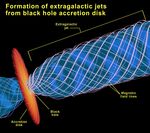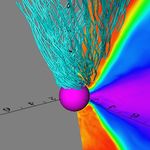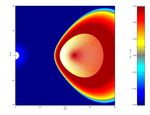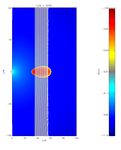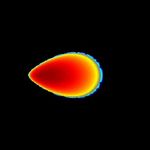Launching Rela-vis-c Jets - John F Hawley University of Virginia
←
→
Page content transcription
If your browser does not render page correctly, please read the page content below
Jets
in
the
80’s
An
imperfect
recollec.on
• VLA
slowly
realizing
its
capability
• Ubiquity
of
jet
phenomenon
beginning
to
be
recognized
• Are
jets
evidence
for
supermassive
black
holes
in
AGN?
• Radio
galaxies
at
high
redshiU
–
implica-ons
for
cosmology
• “Sidedness”
of
jets?
• Jet
morphology
and
interac-on
with
environment
• Hydrodynamic
2D
cylindrical
jet
simula-ons
• Collima-on
mechanisms?
• Thick
tori
–
existence
and
stability?
• Jet
accelera-on:
hydrodynamic,
radia-on
driven,
magne-c
fields?
De
Young,
D.
S.,
Jets
in
Extragalac.c
Radios
Sources,
Nature,
1984
De
Young,
D.
S.,
Astrophysical
Jets,
Nature,
1991
Astrophysical
Jets
Everywhere
• Young
stellar
objects
• X-‐ray
binaries
–
accre-ng
NS
or
BH
• Symbio-c
stars
–
accre-ng
WD
• SupersoU
X-‐ray
sources
–
accre-ng
WD
• AGN
–
accre-ng
supermassive
BH
• Gamma
ray
burst
systems
The
Ubiquity
of
Jets
suggests
that
they
result
from
general
condi-ons.
Gravity
+
Rota-on
(disk
and/or
central
star)
+
Magne-c
fields
Source
of
Energy:
Accre-on
or
rota-on
of
central
star
The Importance of Magnetic Fields Magnetic fields make the ionized gas in an accretion disk spiral inward. The magneto-rotational instability (MRI) is important in accretion disks because it converts stable orbits into unstable motion. Magnetic fields can create stresses inside the marginally stable orbit around a black hole, significantly increasing total efficiency. Magnetic fields can extract energy and angular momentum from spinning holes and drive jets.
Jet Theory • Disk rotation + vertical field: Blandford-Payne type wind/jet • Black Hole rotation + vertical field: Blandford-Znajek Poynting flux jet • Idealized models and axisymmetric simulations with initial vertical fields have demonstrated efficacy of these mechanisms. • Under what circumstances will a large-scale poloidal field be present? Is such a field always required for jet formation? Can such a field be generated in the disk by a dynamo process, or is it brought in from outside?
Global Simulations • Global problem difficult to resolve spatially: turbulent scales to parsecs • Wide range of timescales • Presently limited to simple equation of state • Dissipation, heating, thermodynamics too limited • Only simple radiative losses; no global radiative transfer • System scales with M; density set by assumed accretion rate • Several numerical codes in use by several groups
General Observations: Global Simulations with
Initial Dipole Field
• Accretion disk angular momentum
distribution near Keplerian
• Disk is MHD turbulent; internal
stress due to the magnetorotational
instability
• No abrupt changes at marginally
stable orbit
• Large scale fluctuations and low-m
spiral features
• No stress edge; enhanced efficiency
• Transfer of angular momentum from
black hole to disk
• Implications for the equilibrium spin
of the black hole
• Some studies of disk tilt/mis-
alignment (e.g., Fragile et al.)Simulation Results: Jets • Poynting flux dominated within funnel; only at funnel wall is there significant mass flux • Jet luminosity increases with hole spin – Poynting flux jet is powered by the black hole • Fraction of jet luminosity in Poynting flux increases with spin • Both pressure and Lorentz forces important for acceleration • Existence of funnel jet depends on establishing radial funnel field • Jet power depends on field strength, total flux • Lorentz factor Γ for jet depends on mass loading – this is not reliable in current simulations
Substantial Jet Energy Efficiency for Rapid Spin:
Dipole Initial Field
a/M η EM η NT
-0.9 0.023 0.039
0.0 0.0003 0.057
0.5 0.0063 0.081
0.9 0.046 0.16
0.93 0.038 0.17
0.95 0.072 0.10
0.99 0.21 0.26Tchekhovskoy, McKinney & Narayan 2012
Origin of Large Scale Jet Field • Is net vertical flux required, or just large-scale poloidal field? • Can significant large-scale poloidal field be generated solely by the MRI within turbulent disks? • Can net field be advected inward by MRI turbulent disks? Balance magnetic diffusion/reconnection timescale against accretion timescale • How does the presence or absence of a jet relate to the overall state of the disk and its magnetic field?
Field Topology
• Properties of magnetized black hole accretion disks seem to be remarkably
insensitive to magnetic field topology: the only dependence is in terms of the
magnetic field strength. Appearance of disk should be independent of magnetic field
topology
• This is not true for the jet:
– Jet formation requires a consistent sense of vertical field to brought down to
the event horizon
– This occurs readily for dipole, less so for quadrupole, not at all for toroidal
initial field topologies
– Reconnection events between funnel and disk field determine the variability of
the jetOrigin of the poloidal Funnel Field
From an initial dipole
2D Simulation – thick torus
Color: Plasma Beta
White field linesRadial Advection of Net Vertical
Field
Can net field be brought in from large
distances?Movie: 3D simulation of vertical field model. Vector potential Aφ gradients indicate field line locations
Transport of Net Flux • Global processes can dominate over local processes • Within the turbulent disk (and in turbulent shearing box simulations) magnetic flux can “diffuse” • MRI turbulence (“alpha viscosity”) in disk effective at transporting angular momentum and mass; rapid reconnection prevents effective transport of net flux • Reconnection can make net flux transport nonlocal • “Turbulent magnetic Prandtl number” description not particularly useful
Origin of Large Scale Jet Field: Key Questions
• Is net vertical flux required, or just large-scale poloidal field?
– In simulations, strong jets only form when dipole is brought down to
the hole (consequence of initial conditions)
• Can significant large-scale poloidal field be generated solely by
the MRI within turbulent disks?
– In simulations some coherent initial poloidal field has been required;
there is evidence for a dynamo process in disks, but the effect is
mainly to sustain MRI
• How does the presence or absence of a jet relate to the
overall state of the disk and its magnetic field?
– Funnel field (and jet) strength are related to total pressure in near-
hole disk; rough equipartition
– Initial collimation provided by disk and corona pressureSummary
• The MRI leads to MHD turbulence that transports angular
momentum, allowing disks to accrete
– Stress determines the pressure, not the other way around. It is still
uncertain what determines turbulent field strengths except that
generally field energy is subthermal; field topology, net field, resistivity
and Prandtl number….
– “α Begone!” (Blaes 2007)
• Poynting flux jet power comes from black hole spin
– Under what circumstances does required axial field become
established?
– Can net field be transported inward? Disk transport seems inefficient
but coronal mechanisms may be present
– Large scale fields also seem to be required for jets that originate in
disksYou can also read


